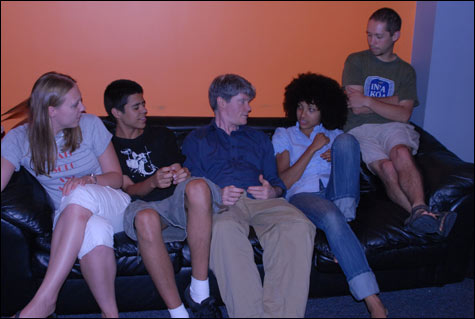
POLYGLOT: Michelin — here with Cyr, son Tiago, Spalding, and Barshay — transcends preconceptions about "Latin jazz." |
If great art and great artists are supposed to contain multitudes, then in music, at least, pianists have the edge: 10 fingers theoretically capable of 10 different simultaneous paths for the music to take. Of course, it's not that simple. A near-mythic figure like the Romanian Dinu Lipatti articulated Chopin as though the weight of each finger were carefully calibrated as they all flew across keys. And the struggle for independence between left and right hands is a constant. When Vladimir Horowitz said, "I wish I had a left hand like Art Tatum's," you can guess that he wasn't talking just about rhythm.
For example, listen to either of two new self-released albums with the Uruguayan-born Boston pianist Nando Michelin: the trio disc Reencontro, and Entre Amigos with guitarist Claudio Ragazzi. In bebop piano, one's ear is drawn naturally to the flowing lines of eighth and 16th notes in the right hand, with the left hand marking spare chordal rhythms. But in the title tune of Reencontro, you'll notice almost subliminally another voice emerging behind the piano solo — until you realize that, in addition to marking chord progressions and rhythms, Michelin's left hand is spelling out melodies independent of his right, with both chords and single-note phrases. Michelin, who came to Berklee from Montevideo in 1989, has long been one of Boston's most respected — and busiest — pianists, fluent in a multitude of Latin-American and jazz styles. But that independence is part of his own special magic. And so is giving unity to a multiplicity of voices.
Michelin (who plays with Sofia Koutsovitis at Berklee on February 1 and at the Beehive with a trio on February 2) fell in love with jazz as a 19-year-old chemistry major in Montevideo — first Dexter Gordon, then the classic Atlantic album Coltrane's Sound. A Berklee clinic in Argentina led to his dropping chemistry for music and coming to Boston. He gained a reputation for his versatility — he could play tango with the Argentines (as on the album with Ragazzi), bossa nova and samba with the Brazilians, and post-Coltrane bebop with Jerry Bergonzi. He's been a regular in Brazilian singer-songwriter Teresa Inês's bands as well as fellow Uruguayan Florencia Gonzalez's various candombe-based projects, and with the Argentine Koutsovitis.
It would be unfair to characterize Reencontro (like its predecessor, the 2006 Fresh Sound New Talent disc Duende) as a "Latin-jazz" album. It's a jazz album, period. But it's Michelin's multi-idiom fluency that gives each piece its distinct cast. So the 5/4 rhythm of the whimsical closing "Kekume" is based loosely on the Uruguayan murga rhythm, which toward the end of the piece shifts to a hard Afro-Cuban clave. Michelin describes the lovely ballad-tempo number "Paula," which he wrote for his wife, as "halfway between a samba and a Uruguayan candombe."
"My wife is Brazilian," he explains over the phone from his Arlington home. He first presented the piece to another regular collaborator, Argentine bassist Fernando Huergo, as a samba. The harmony was indeed very Brazilian. But the rhythm of the melody line itself had another voice. "Fernando said, 'This is a candombe. Let's not force it into a Brazilian thing.' " Mixing the two idioms, the piece becomes a kind of double portrait of the married couple. "You can't really say it's one or the other," Michelin maintains. "And my wife has been with me so long . . . "